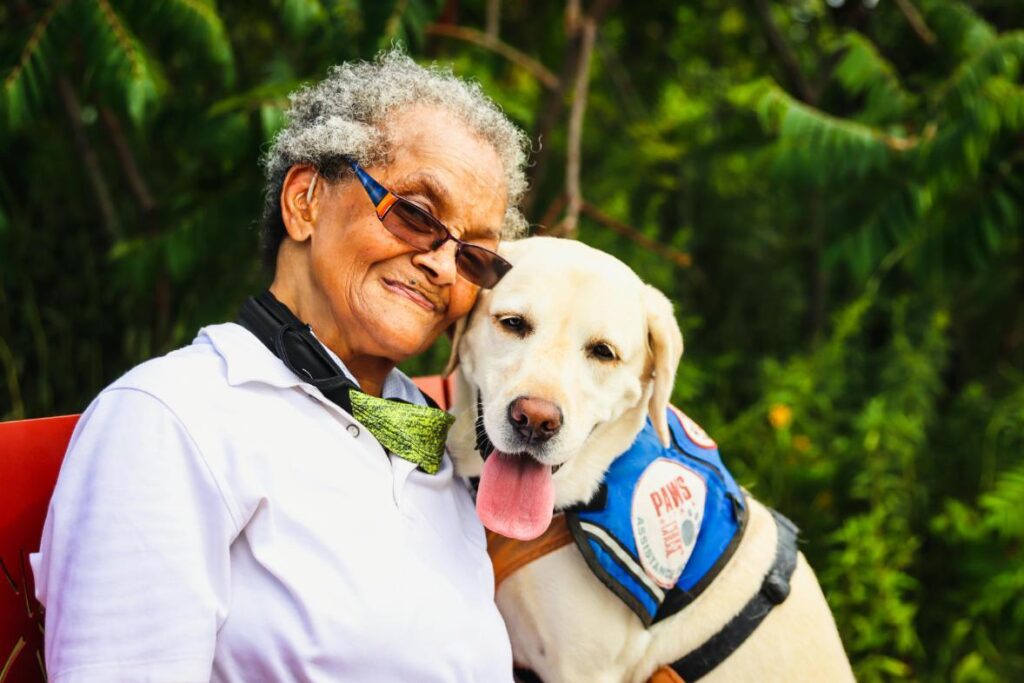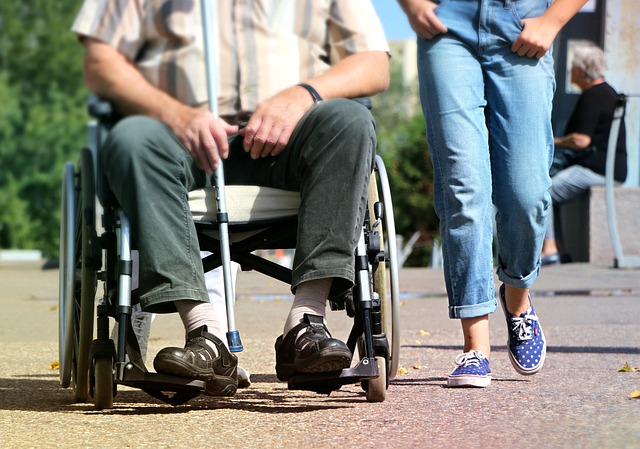The Benefits of Pet Therapy

In recent years, pet therapy—also known as animal-assisted therapy (AAT)—has become a popular and respected approach in both healthcare and care home settings. From therapy dogs visiting nursing homes to guinea pigs offering comfort to older adults, animal-assisted interventions are increasingly recognised for their wide-ranging physical and mental health benefits.
At Struan Lodge Care Home, we understand the importance of nurturing the well-being of our residents through meaningful activities. Incorporating animal-assisted therapy into our care approach allows residents to enjoy companionship, reduce stress levels, and experience genuine joy through human-animal interactions. But what exactly is pet therapy, and what makes it so effective?
What Is Pet Therapy?
Pet therapy, or animal-assisted therapy, is a therapeutic approach that uses trained animals to support a person’s physical, emotional, and psychological well-being. Commonly used animals include dogs, cats, guinea pigs, rabbits, and even farm animals, depending on the setting and participants’ comfort levels.
Unlike casual pet ownership, pet therapy sessions are carefully structured and overseen by healthcare providers or trained professionals. These therapy sessions form part of wider animal-assisted intervention programs, which can be applied in hospitals, educational settings, nursing homes, and even rehabilitation centres.
The animals used in AAT undergo specialised training to ensure they are calm, responsive, and able to promote positive emotional responses during interactions.
The Human-Animal Bond: Why It Matters
At the heart of animal therapy is the human-animal bond—the unique emotional connection that forms between people and animals. Research studies have shown that human-animal interactions can produce measurable physiological stress responses, such as lower blood pressure, slower heart rate, and reduced levels of stress hormones.
This calming effect can be especially beneficial for older adults in care home environments, helping to promote relaxation, reduce feelings of loneliness, and elevate mood. In many cases, therapy animals help residents express emotions or memories that might otherwise remain hidden, enhancing overall emotional well-being.
The Physical Health Benefits of Pet Therapy
One of the most well-documented benefits of animal-assisted therapy relates to physical health. Studies, including systematic literature reviews and randomised controlled studies, have demonstrated that interacting with animals can support cardiovascular health and reduce high blood pressure.
1. Improved Heart Health
The simple act of stroking a therapy dog has been shown to reduce blood pressure and heart rate, creating a calming presence that supports heart health and lowers cardiovascular risk.
2. Increased Physical Activity
For residents who are able, dog-assisted therapy encourages gentle physical activity, such as short walks, brushing, or throwing a ball. This type of movement not only improves motor skills and mobility but also complements physical rehabilitation and physical therapy programmes.
3. Boosting Immune and Endocrine Function
Research suggests that regular human-animal interactions may even have an impact on the immune system, potentially supporting overall public health outcomes by reducing stress-related inflammation.
The Mental Health Benefits of Pet Therapy
While animal-assisted therapy can enhance physical health, its greatest strength often lies in its impact on mental health and emotional regulation.
1. Reducing Anxiety and Depression
Pet therapy programs have been shown to lower anxiety levels and ease symptoms of depression across different age groups. The calming effect of therapy animals—particularly dogs—can help people with mental health conditions find comfort and grounding during therapy sessions.
2. Supporting Trauma Recovery
For those living with post-traumatic stress disorder (PTSD), canine-assisted psychotherapy has produced remarkable results. Trained animals can provide reassurance and stability, helping individuals manage flashbacks or panic attacks through gentle, non-verbal comfort.
3. Enhancing Cognitive Function
In older adults, particularly those with dementia or memory loss, animal-assisted activities have been shown to stimulate cognitive function and social interaction. Stroking or talking to an animal can trigger memories, improve focus, and encourage verbal communication.
4. Promoting Social Skills and Connection
Group pet therapy sessions can help residents build social skills and foster social support among peers. Interacting with a shared animal creates a sense of community and shared joy, breaking down barriers of isolation.
Complementary Treatment for Mental Health Conditions
Animal-assisted therapy (AAT) is not intended to replace conventional mental health treatments, but rather to act as a complementary treatment. When combined with counselling, medication, or physical therapy, AAT provides an additional layer of emotional support and motivation.
The growing body of qualitative and quantitative evidence suggests that incorporating animal-assisted therapy into broader care plans can improve engagement and compliance with traditional therapies. In this way, AAT serves as a bridge between alternative therapies and clinical approaches.

Animal-Assisted Therapy in Nursing Homes
At Struan Lodge Care Home, we see first-hand how therapy animals can transform the atmosphere within our home. Many residents look forward to visits from therapy dogs or guinea pigs, which can brighten their day and provide comfort.
In nursing homes, animal-assisted interventions can help reduce behavioural symptoms associated with dementia, such as agitation or restlessness. The calming effect of an animal’s presence helps to stabilise emotions, improve psychological well-being, and encourage meaningful social interaction.
These benefits vary greatly depending on each individual’s health and background, but the overall mental benefits are consistent—residents often show improved mood, greater engagement, and reduced loneliness after interacting with therapy animals.
Evidence Supporting Pet Therapy
A wealth of research studies has examined the health benefits of pet therapy and animal-assisted interventions.
A systematic review of animal-assisted therapy (AAT) found that it can significantly reduce stress levels and improve emotional well-being in people with mental health conditions. Similarly, quantitative evidence from randomised controlled studies shows measurable improvements in blood pressure, heart rate, and cognitive function following interactions with trained animals.
Qualitative research also highlights the deep emotional connection formed through human-animal bonds, noting improvements in psychological well-being, social skills, and emotional regulation.
Although there are ethical considerations—such as managing animal dander and ensuring animal welfare—the consensus across literature reviews and systematic studies supports the use of animal-assisted interventions as a safe and effective therapeutic approach.
Types of Therapy Animals
The types of animals used in pet therapy can vary greatly depending on the setting and goals of the programme.
- Dogs are the most common, known for their empathy and ability to read human emotions. Therapy dogs participate in dog-assisted therapy and canine-assisted psychotherapy.
- Cats offer a soothing calming presence, ideal for individuals with high anxiety.
- Guinea pigs and rabbits are gentle and approachable, making them suitable for those who may be nervous around larger animals.
- Farm animals, such as horses, goats, and donkeys, are sometimes used in animal-assisted activities on larger care campuses or outdoor settings.
Each animal type offers unique benefits, and their inclusion in animal-assisted intervention programs can be tailored to specific age groups and healthcare needs.
Ethical Considerations and Best Practices
When introducing animal therapy into care home environments, it’s essential to consider ethical guidelines to ensure the safety and welfare of both residents and animals.
Healthcare providers and therapists must ensure that all therapy animals receive proper specialised training, vaccinations, and regular health checks. Additionally, the environment should be assessed for potential allergens, such as animal dander, and the emotional needs of participants should always be respected.
By following best practice, animal-assisted interventions can safely deliver profound benefits across physical and mental domains.
Why Struan Lodge Supports Pet Therapy
At Struan Lodge Care Home, we are committed to promoting well-being in every form—physical, emotional, and social. Our dedicated team recognises the incredible potential of human-animal interactions to elevate mood, reduce anxiety levels, and encourage social interaction among residents.
Whether through regular visits from therapy dogs, interactive pet therapy programs, or occasional animal-assisted activities, our aim is to create a calm, joyful, and inclusive environment that supports mental health, physical rehabilitation, and overall quality of life.
Looking to the Future: Animal Therapy as a Mainstream Intervention
As the evidence base grows, animal-assisted therapy is becoming increasingly recognised as a valuable component of modern healthcare and public health strategies. With ongoing research studies and systematic reviews continuing to validate its effectiveness, more nursing homes and healthcare providers are incorporating AAT into their everyday care practices.
The benefits of pet therapy extend far beyond temporary happiness—they represent a bridge between science, compassion, and the timeless comfort of companionship.
At Struan Lodge, we believe that the simple presence of an animal can make an extraordinary difference, offering both physical and mental healing and fostering a deeper sense of well-being for all who call our care home their home.




